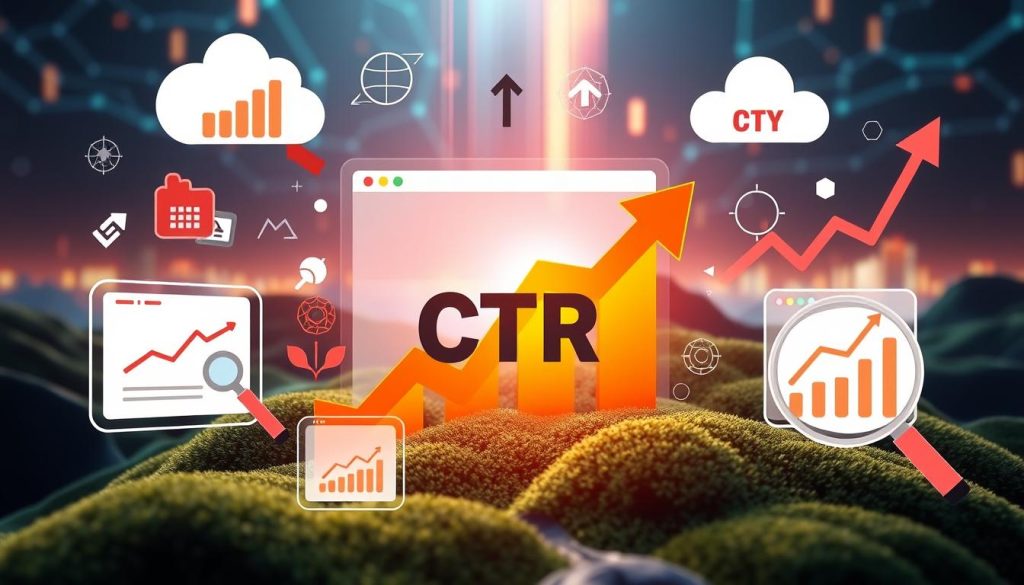Click-through rate (CTR) in SEO has been a hot topic for years. Google denies CTR as a ranking factor, but it remains crucial for SEO professionals. This metric is still important to monitor and optimize.
We’ll explore CTR’s importance in SEO and Google’s stance on it. We’ll also discuss ethical ways to boost your click-through performance.
Key Takeaways
- Click-through rate (CTR) is a crucial metric for SEO, even if it’s not a direct ranking factor.
- Google has denied that CTR is used as a ranking signal, but it still plays a role in user experience and engagement.
- Ethical CTR optimization tactics include improving titles, meta descriptions, and URL structure.
- Avoid click-through rate manipulation techniques like ad fraud, invalid traffic, and click spam, as they can result in penalties.
- Complement CTR optimization with paid advertising, email marketing, and social media to diversify your traffic sources.
Understanding Click-Through Rate (CTR)
Click-through rate (CTR) is a key metric in digital marketing. It shows how often people click on a link or ad they see. For SEO, CTR measures clicks on your organic search results in Google.
What is CTR and How is it Measured?
CTR is the number of clicks divided by the total impressions. Impressions are the times your link or ad appears. For instance, if your result shows 100 times and gets 5 clicks, your CTR is 5%.
Google’s Search Console offers detailed CTR data for organic search performance. This tool helps you understand how your content connects with your audience.
The Role of CTR in SEO
- CTR shows how relevant and quality your content is to users.
- High CTR may signal search engines that your content deserves higher rankings.
- Optimizing titles, meta descriptions, and URLs can boost your SEO CTR and organic traffic.
Managing your click-through rate is crucial for SEO success. Focus on creating relevant, engaging content for users.
This approach can improve your website’s click-through rate measurement and boost search engine visibility.

Is CTR a Ranking Factor?
The impact of click-through rate (CTR) on Google’s search rankings has been debated for years. Google denies CTR’s direct influence on rankings. However, the situation is more complex than it appears.
Google’s Stance on CTR as a Ranking Signal
Google consistently denies using CTR as a ranking factor. John Mueller, a Google Search Advocate, addressed this in 2021. He stated that if CTR drove rankings, search results would be full of click-bait.
Google argues that CTR can be easily manipulated. Relying on it could lower search quality. Instead, Google aims to provide relevant and useful results to users.
| CTR as a Ranking Factor | Google’s Position |
|---|---|
| CTR ranking factor | Denied |
| CTR as ranking signal | Rejected |
| Google’s position on CTR | CTR does not drive search rankings |
CTR may not directly affect rankings, but it can indirectly impact website visibility. User engagement metrics can influence Google’s perception of a page’s relevance. This, in turn, can affect its rankings.

CTR remains an important metric in SEO strategies. Creating content that encourages high CTRs can boost your website’s visibility. It can also improve your site’s performance in search results.
Correlation Studies on CTR and Rankings
Click-through rate (CTR) and search rankings have a complex relationship. Studies show high-ranking pages often have better CTRs. But correlation doesn’t mean causation in this case.
A high CTR doesn’t guarantee Google uses it for ranking. Google’s algorithms are more complex than that. They use advanced AI to assess website quality and relevance.
These algorithms likely consider many user experience factors. They don’t just rely on indirect metrics like CTR. Instead, they evaluate a webpage’s true value.
- CTR correlation studies show a positive link between high-ranking pages and their click-through rates.
- However, this correlation does not necessarily mean that CTR is a direct ranking factor used by Google.
- Google’s algorithms are believed to utilize complex machine learning and AI to evaluate the overall user experience and relevance of a website, rather than focusing solely on CTR.

CTR and rankings are connected, but Google’s system is complex. Marketers should focus on improving overall user experience. This approach is better than just trying to boost CTR.
Ethical CTR Optimization Tactics
Businesses can boost organic click-through rates (CTR) ethically. Ethical CTR optimization tactics enhance digital presence while following search engine rules. Companies can improve their online visibility without resorting to shady practices.
Improving Titles and Meta Descriptions
Optimizing page titles and meta descriptions is a powerful strategy. Compelling, keyword-rich title optimization can significantly boost CTR. These elements are crucial for engaging users in search results.
Meta description optimization provides a brief, informative preview of page content. Well-crafted descriptions entice users to click through, improving overall engagement.
Optimizing URLs for Clarity
URL optimization is another ethical tactic for improving CTR. Clear, descriptive URLs enhance user experience and increase click-throughs. Avoid complex or over-optimized URLs to maintain transparency and trust.
A professional marketing firm can help optimize web pages for SEO best practices. This approach improves organic CTR while upholding ethical standards. It also helps avoid search engine penalties.
click-through rate manipulation
Click-through rate (CTR) is vital in digital marketing. It measures content, advertising, and SEO success. Sadly, some manipulate CTR, creating a deceptive online landscape.
This manipulation undermines data integrity. It affects the reliability of marketing metrics. Honest businesses suffer as a result.
Defining Click-Through Rate Manipulation
CTR manipulation artificially boosts clicks on websites or ads. It’s done without real user interest. Automated “click bots” or “click farming” are common methods.
Types of CTR Manipulation
- Click Fraud: The use of bots or fraudulent clicks to inflate CTR, often for the purpose of generating revenue or obscuring the true effectiveness of advertising campaigns.
- Click Farms: The practice of hiring people, often in developing countries, to manually click on links and advertisements, creating the illusion of genuine user interest.
- Ad Fraud: The exploitation of online advertising systems by using bots, scripts, or other means to generate fake impressions and clicks, leading to inflated ad revenue.
- Invalid Traffic: The inclusion of non-human traffic, such as bots, crawlers, or other automated sources, in website analytics and performance metrics.

These tricks hurt online data accuracy. They cause big money losses for advertisers and publishers. Search engines are fighting back against CTR manipulation.
Businesses must use ethical ways to boost CTR. This ensures real user engagement. It protects the integrity of digital marketing.
Risks and Penalties of CTR Manipulation
CTR manipulation is a risky and unethical practice with severe consequences for businesses. It’s a form of click fraud that artificially inflates ad clicks. This can be done through bots or real people, but it’s still fraudulent.
Search engines like Google are getting better at spotting CTR manipulation. Penalties can include loss of organic visibility and reduced search rankings. In extreme cases, businesses might face permanent bans from search engines.
CTR manipulation can also harm a company’s reputation. Consumers value authentic marketing practices and may lose trust in deceptive businesses. A damaged reputation can have long-lasting effects on customer retention.
| Risks of CTR Manipulation | Potential Penalties |
|---|---|
|
|
The risks of CTR manipulation outweigh any short-term gains. Businesses should focus on ethical SEO practices to improve visibility and engagement. This approach is more sustainable and avoids potential downfalls associated with deceptive tactics.
Alternatives to CTR Manipulation
Businesses might feel tempted to use unethical CTR manipulation tactics for better SEO metrics. However, ethical alternatives can provide a better return on investment. These options are more effective when executed properly.
Paid Advertising and PPC Campaigns
Investing in paid advertising and PPC campaigns is a solid alternative to CTR manipulation. These methods can drive targeted traffic to your website. They may cost more but can generate high-quality leads.
Carefully craft your ad campaigns and target the right audience. This approach can boost your visibility in search results.
Email Marketing and Social Media
Email marketing and social media are powerful tools for driving traffic. Build an engaged audience through newsletters and social platforms. This strategy can improve your overall online presence.
These methods may take more time and effort. However, they offer a sustainable and ethical approach to enhancing SEO metrics.
Focus on creating high-quality, valuable content that speaks to your target audience. Prioritize user experience and provide genuine value. This builds trust and authority, leading to more organic traffic.
| Strategy | Advantages | Disadvantages |
|---|---|---|
| Paid Advertising and PPC Campaigns |
|
|
| Email Marketing and Social Media |
|
|
Ethical alternatives to CTR manipulation can boost SEO metrics effectively. These strategies drive sustainable, long-term growth without compromising integrity. They also help avoid potential penalties from search engines.
Measuring and Analyzing CTR Data
Measuring click-through rate (CTR) data is vital for optimizing SEO efforts. CTR offers insights into user behavior, helping identify low-performing pages and content-intent mismatches. It also uncovers long-tail keyword opportunities.
Tracking CTR data reveals information to enhance user experience and improve SEO performance. This approach can transform your digital marketing strategy. It helps find pages needing content updates and discover promising keyword targets.
Tracking and Monitoring CTR
To measure CTR data effectively, set up a robust tracking system. Use tools like Google Analytics, Search Console, and other SEO platforms. These will help monitor your website’s CTR across various channels and campaigns.
Comprehensive data collection enables informed decisions and content optimization. Review CTR data regularly to spot trends and patterns. Analyze CTR across pages, keywords, and traffic sources for insights.
- Regularly review your CTR data to identify trends and patterns.
- Analyze CTR across different pages, keywords, and traffic sources to uncover insights.
- Investigate pages with low CTR to understand why users may not be engaging with your content.
Leveraging CTR Data Insights
After understanding your CTR data, put those insights into action. Analyze titles, meta descriptions, and URLs to find areas for improvement. Optimize these elements to align with user intent and drive higher CTR.
| Metric | Average | Top Performers | Bottom Performers |
|---|---|---|---|
| Overall CTR | 3.5% | 5.2% | 1.8% |
| Branded CTR | 6.1% | 8.4% | 3.7% |
| Non-Branded CTR | 2.1% | 3.6% | 0.9% |
Use CTR data insights to optimize content and boost SEO performance. Keep tracking, analyzing, and acting on this valuable information. This will help drive more qualified traffic and enhance user experience.
“Analyzing your CTR data is not just a nice-to-have, it’s a must-have for any serious digital marketer. The insights you uncover can be transformative in improving your search engine visibility and driving meaningful engagement with your target audience.”
Conclusion
CTR’s role in SEO remains a hot topic. Yet, it’s crucial for a website’s online success. Ethical optimization of titles, meta descriptions, and URLs can boost CTR significantly.
Analyzing CTR data helps companies make smart SEO decisions. It shows where to improve and how to boost user engagement. This approach strengthens overall website performance.
The debate on CTR’s ranking influence continues. But focusing on user experience is key. Ethical practices in SEO set businesses up for success.
A comprehensive SEO strategy unlocks a website’s full potential. It helps organizations achieve their online goals effectively. Embracing this approach leads to better results in the digital world.
FAQ
What is CTR and how is it measured?
What is the role of CTR in SEO?
Is CTR a ranking factor for Google?
What is the difference between correlation and causation when it comes to CTR and rankings?
What are some ethical tactics to improve organic CTR?
What is click-through rate manipulation?
What are the risks and penalties of CTR manipulation?
What are some alternatives to CTR manipulation?
How can businesses measure and analyze CTR data?
Source Links
- Avoiding Click-Through Rate Manipulation | elk – https://elkhq.com/blog/click-through-rate-manipulation
- Do CTR manipulation services actually work to improve rankings? – https://moz.com/community/q/topic/60798/do-ctr-manipulation-services-actually-work-to-improve-rankings
- Is click-through rate a valuable SEO metric? – https://searchengineland.com/click-through-rate-seo-metric-395858




